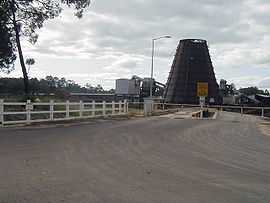Yarloop, Western Australia
| Yarloop Western Australia | |
|---|---|
 Timber mill at Yarloop | |
 Yarloop | |
| Coordinates | 32°57′18″S 115°54′00″E / 32.955°S 115.90°ECoordinates: 32°57′18″S 115°54′00″E / 32.955°S 115.90°E |
| Population | 545 (2006 Census)[1] |
| Established | 1894 |
| Postcode(s) | 6218 |
| Location |
|
| LGA(s) | Shire of Harvey |
| State electorate(s) | Murray-Wellington |
| Federal Division(s) | Forrest |
Yarloop is a town located in the South West of Western Australia along the South Western Highway, between Waroona and Harvey. At the 2006 census, Yarloop had a population of 545.[1]
History
The name Yarloop is said to have originated from the words "yard loop"; the rail loop into the timber yard there. However, the name is more likely Aboriginal in origin (most likely from the local Bindjareb Noongar people). Yalup Brook is situated only about 5 km north of Yarloop and there is similarity in pronunciation of the word and the early spelling variations of the siding (Yailoup and Yarloup) support it being Aboriginal.[2]
In 1849, Joseph Logue arrived in the area and farmed at nearby Cookernup. He was followed by W.J. Eastcott, who used to collect red gum bark and pit-saw timber for other settlers, and John Bancells in 1886.
In 1894, Charles and Edwin Millar moved into the district looking to put nearby stands of jarrah to use - they had exported jarrah blocks to London for use in street paving. They soon established their own 300-acre (1.2 km2) timber town with accommodation and support facilities, located 2 km south of a government-surveyed town site as the company wished to maintain effective control over staff and workmen. However, not everyone working at the mill wanted to live in the facilities, so a company town on the eastern side of the railway and a public town on the western side developed. A siding on the Perth-Bunbury Railway came into being in 1896.
In 1901, they made Yarloop the centre of their operations, and the town became even more important when in 1905 they closed their Denmark mills on the south coast. At their peak, they employed over 500 people in the Yarloop area. By the 1930s, they boasted the largest private railway in the world with eight railway systems and 25 locomotives. The timber mill, originally known as the Waigerup mill, still operates and in 1984 the mill town was classified as a conservation area by the [3] and is now protected by the Yarloop Conservation Plan (1998) administered by the Heritage Council.[4]
The town was gazetted in 1962.[2][5]

Present day
Yarloop is today home to citrus growers, dairy farmers and millers. The town centre includes many restored timber buildings along with the historical steam workshops. The work shops have many operating steam engines along displays of the equipment used to maintain 25 steam locos and the timber production of millers. There is a heritage trail around the old mill town and conservation area. Facilities include primary school, local shops and various types of accommodation.
A notable issue in the town is emissions from the Alcoa alumina refinery at nearby Wagerup. For years, some residents have reported illnesses such as respiratory irritation, frequent blood noses, headaches, nausea and cancer, as reported in numerous media outlets, including the ABC's Four Corners program 'Something In The Air',[6] although no formal causal link has ever been established. Alcoa subsequently obtained permission (September 2006) to double the size of the refinery to become the biggest such refinery in the world, although very strict conditions have been imposed on the expansion by the Health and Environment departments. Residents have already announced plans to fight the decision in the Supreme Court.[7][8][9] As a result, the future of the town remains distinctly uncertain.
Transport
Yarloop is situated on the South Western Railway, and is a stopping place for the Australind passenger train from Perth to Bunbury.
| Preceding station | Transwa Trains network | Following station | ||
|---|---|---|---|---|
towards Perth |
Australind | towards Bunbury |
References
- ↑ 1.0 1.1 Australian Bureau of Statistics (25 October 2007). "Yarloop (L) (Urban Centre/Locality)". 2006 Census QuickStats. Retrieved 25 July 2011.
- ↑ 2.0 2.1 Western Australian Land Information Authority. "History of country town names". Retrieved 2007-04-17.
- ↑ http://www.ntwa.com.au National Trust
- ↑ The Sydney Morning Herald (8 February 2004). "Yarloop". Retrieved 2006-10-06.
- ↑ Shire of Harvey. "Local Towns - Yarloop". Retrieved 2006-10-06.
- ↑ http://www.abc.net.au/4corners/content/2005/s1471209.htm
- ↑ News.com.au (8 September 2006). "Hamel, Cookernup and Yarloop in the firing line". The Sunday Times. Retrieved 2006-10-05.
- ↑ News.com.au (15 September 2006). "Alcoa to be biggest in world". news.com.au. Retrieved 2006-10-05.
- ↑ ABC News, 15 September 2006, accessed 6 October 2006.
External links
- Map of Yarloop (Shire of Harvey)
| ||||||||
| ||||||||